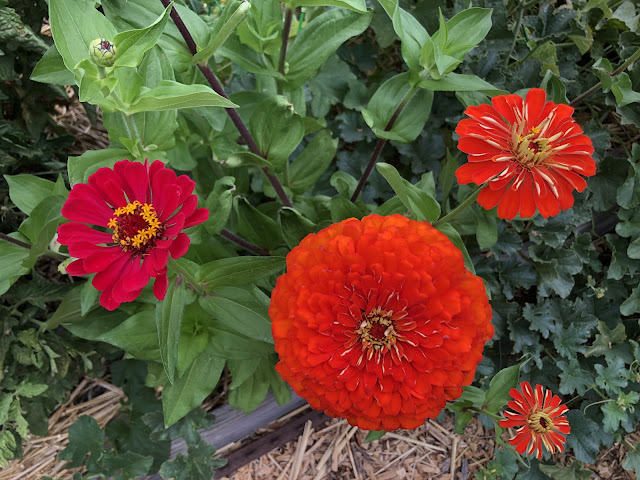
August starts with ‘normal’ temperatures and opportunities to get things done

|
| Zinnias brighten any landscape, and entice pollinators, too. (Photo: Kathy Morrison) |
After so many triple-digit days in July, the start of August actually feels on the cool side.
According to the National Weather Service, Sacramento will see a steady string of afternoons in the low 90s with overnight lows dipping down close to 60. Historically, that’s normal; average temperatures for Sacramento in August: High of 91 degrees and low of 58.
This mild summer weather is great for plants – and for getting things done. Tackle chores and watering in the morning before temperatures edge up in the afternoon. Remember: Always water before fertilizing.
* Pick up after your fruit trees. Clean up debris and dropped fruit; this cuts down on insects and prevents the spread of brown rot.
* Feed citrus trees their last round of fertilizer for the year. This will give a boost to the fruit that’s now forming.
* Feed other fruit trees, too, with slow-release fertilizer for better production for next year.
* Camellia leaves looking a little yellow? Feed them some chelated iron. That goes for azaleas and gardenias, too.
* To prolong bloom into fall, feed begonias, fuchsias, annuals and container plants.
* Fertilize fall-blooming perennials, too. Chrysanthemums can be fed until the buds start to open.
* Harvest tomatoes, beans, squash, pepper and eggplants to prompt plants to keep producing. Give your plants a deep watering twice a week, more if planted in containers.
* Give tomatoes and peppers a boost with phosphate-rich fertilizer to help fruiting.
* Watch out for caterpillars and hornworms in the vegetable garden. They can strip a plant bare in one day. Pick them off plants by hand in early morning or late afternoon.
* In the vegetable garden, direct seed beets, carrots, leaf lettuce and turnips.
* Plant potatoes.
* Pinch off dead flowers from perennials and annuals to lengthen their summer bloom.
* Deadhead roses for more flowers in early fall.
* Indoors, start seedlings for fall vegetable planting, including bunching onion, cabbage, broccoli, cauliflower, kale, radicchio and lettuce.
* Sow seeds of perennials in pots for fall planting including yarrow, coneflower and salvia.
Comments
0 comments have been posted.Sacramento Digs Gardening to your inbox.
Sites We Like
Garden Checklist for week of April 21
This week there’s plenty to keep gardeners busy. With no rain in the immediate forecast, remember to irrigate any new transplants.
* Weed, weed, weed! Get them before they flower and go to seed.
* April is the last chance to plant citrus trees such as dwarf orange, lemon and kumquat. These trees also look good in landscaping and provide fresh fruit in winter.
* Smell orange blossoms? Feed citrus trees with a low dose of balanced fertilizer (such as 10-10-10) during bloom to help set fruit. Keep an eye out for ants.
* Apply slow-release fertilizer to the lawn.
* Thoroughly clean debris from the bottom of outdoor ponds or fountains.
* Spring brings a flush of rapid growth, and that means your garden is really hungry. Feed shrubs and trees with a slow-release fertilizer. Or mulch with a 1-inch layer of compost.
* Azaleas and camellias looking a little yellow? If leaves are turning yellow between the veins, give them a boost with chelated iron.
* Trim dead flowers but not leaves from spring-flowering bulbs such as daffodils and tulips. Those leaves gather energy to create next year's flowers. Also, give the bulbs a fertilizer boost after bloom.
* Pinch chrysanthemums back to 12 inches for fall flowers. Cut old stems to the ground.
* Mulch around plants to conserve moisture and control weeds.
* From seed, plant beans, beets, cantaloupes, carrots, corn, cucumbers, melons, radishes and squash.
* Plant onion sets.
* In the flower garden, plant seeds for asters, cosmos, celosia, marigolds, salvia, sunflowers and zinnias.
* Transplant petunias, zinnias, geraniums and other summer bloomers.
* Plant perennials and dahlia tubers for summer bloom.
* Mid to late April is about the last chance to plant summer bulbs, such as gladiolus and tuberous begonias.
* Transplant lettuce seedlings. Choose varieties that mature quickly such as loose leaf.